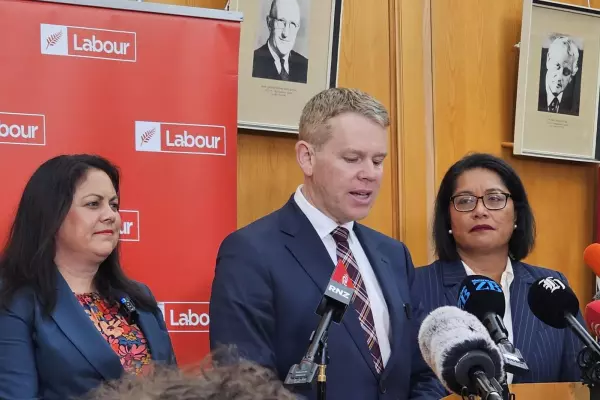Pictured: David Parker and Tony Randerson release the RMA review, July 2020
Thirty years ago, not quite to the day, a newly anointed National Party minister for the environment was poring over the detail of a massive new piece of environmental legislation, which had yet to become the Resource Management Act.
Developed by Labour’s priest of high legal principle, Geoffrey Palmer, the Resource Management Bill didn’t quite make it into law in 1990 before the shambolic remains of the government formed by David Lange in 1984 was summarily turfed by voters late that year.
It was left to Simon Upton, a Palmer equivalent on National’s side of the House for his cerebral commitment to grappling with knotty policy problems, to shepherd the RMA into being.
So, while that government’s finance minister, Ruth Richardson, was preparing to fillet the welfare state in the 1991 ‘Mother of all Budgets’, Upton steered to its conclusion the most debated, derided, mistakenly blamed and contentious pieces of legislation of the last generation.
Endlessly amended, ever longer, and subject to much fundamental interpretation by the courts, the RMA was supposed to improve the state of the natural environment while enabling investment in economic development, the growth of cities and the emergence of new industries.
It didn’t work.
It’s possible things might be worse if the RMA hadn’t existed, but the state of the NZ environment is considerably worse, 30 years after the RMA became law.
After about 25 years, there was eventual agreement across the Parliament that the RMA had to be replaced, even if consensus on the replacement wasn’t clear.
Being a glutton for punishment like both Palmer and Upton, in 2019 Environment Minister David Parker bit the bullet and appointed a committee of experts to advise on what that reform should look like.
The Randerson factor
For consistency’s sake or perhaps because he has a sly sense of humour, Parker appointed retired Environment Court judge Tony Randerson to lead the process — the very same Tony Randerson whom Upton appointed in 1991 to review the RMA as he’d inherited from Palmer.
In July last year, Randerson reported, delivering a mammoth 531 page report, replete with its own draft legislation. Reduced to bare bones, the Randerson review advocated splitting environmental and planning law into two pieces of legislation.
First, there would be a Natural and Built Environments Act covering much of the detail the RMA now covers.
And second, a Strategic Planning Act, which is arguably the more important part of the reform. The SPA would require a ‘spatial planning’ approach, which means deciding at a high level and well ahead of time, what will be allowed to be developed where. Think Pukekohe volcanic soils — housing or vegetables? Or where to put roads, railway lines, and the other infrastructure needed in future.
Arriving as it did in the midst of the covid-19 crisis, shortly before what was to have been a September general election, the Randerson report seemed almost to be some sort of last straw.
The lawyers, planners, local body policy wonks, property developers, farming lobbyists, miners, climate change activists and anyone else who lives and dies by core planning and environmental legislation have produced almost no public response.
After all, Parker had promised to do nothing before the election. It’s almost as if everyone thought: ‘we’ll deal with that next year.’
Well, it’s next year.
Process emerging
A timetable and process for RMA reform is starting to emerge.
Crucially, Randerson’s draft legislation will not be treated as a blueprint for the new legislation. The government is in a hurry, but not that much of a hurry.
Rather, some time in May, officials will produce an exposure draft of new law, for public consultation. That will inform the draft that will go Parliament and, the gods willing, there could be new legislation in place by the end of this year.
However, the somnolence to date should not be mistaken for the reforms getting an easy ride.
Not everyone has been either asleep at the wheel or keeping their powder dry following the Randerson report.
Thirty years on, Simon Upton has re-emerged after a glittering career in environmental policy at the OECD in Paris, to be NZ’s Parliamentary Commissioner for the Environment.
And in that role, he’s had a damn good look at the Randerson report. While good in parts, he has some serious quibbles, which he expressed in a little-reported speech last October to the Resource Management Law Association.
The speech is pure Upton — densely argued, highly persuasive, includes an alternative redrafting of the RMA, and is extremely difficult to summarise for the lazy or the time-poor.
Upton's gripes
But let me try with this incomplete list:
1. Randerson’s drafting is woolly, Upton argues, without using that word. For example, it nominates no fewer than “21 discrete, unprioritised outcomes”, creating a legal thicket in which lawyers, planners, resource consent objectors and environmentalists alike could hide even more effectively than in the current RMA.
“Simply calling for the achievement of positive outcomes for an environment framed as broadly as this is little more than a wish that all should be well with the world,” Upton observes waspishly.
“It doesn’t lend itself to a world of legal duties, rights and responsibilities which address very different sorts of bio-physical, cultural and economic circumstances.”
The wide-ranging outcomes “will inevitably come into conflict” so that “simply spelling out a raft of new outcomes will not make them compatible with one another. We will need to be much more sophisticated than that.”
2. Randerson monkeys too much with part two of the RMA — its purpose clause — which Upton suggests has achieved quasi-constitutional status and should be changed only “with great caution”, for reasons set out in point four below.
3. The proposals set low bars for environmental protection while appearing to set new, higher bars by linking back to the “overly broad purpose provision.” Since the courts will always get involved in resource and environmental disputes, he fears they would be falling back on “a purpose provision that given now priority to the natural environment.”
4. Perhaps without meaning to, the Randerson proposals reopen the door to the idea that economic and environment priorities can be “balanced.” This is at the heart of the tussle over the way the current RMA works. Unless there are environmental limits which cannot be gone beyond, the environmental protection purpose of any RMA-variant is defeated, Upton argues.
5. Is separate spatial planning law really necessary “on an already overburdened statute book?” Upton believes spatial plans are “the pivotal point of integration between the natural environment and planning for change and growth” … but we don’t need a separate statute to institute them.”
6. Finally, there is Upton’s timely caution that the arguments blamed on the RMA were not generally caused by the RMA.
Rather, they are the inevitable arguments that occur when private property rights meet public good aspirations and requirements. This is the basic stuff of all politics.
“Statutory spring-cleaning is not going to lead to peace, harmony, and goodwill towards planners,” Upton said. “Some of the conflicts that are giving rise to current dissatisfaction are eternal and will persist no matter what statutory framework is enacted.”
Politics vs laws
In a way, Upton is issuing a general call to us all to just grow up.
The world is changing fast. One reason the RMA didn’t protect the environment was that the 1990 NZ economy was one in which agriculture was in decline and the population was static or falling and when climate change was a new idea, not an urgent problem.
Thirty years later, dairy intensification, mass tourism and rampant inward immigration to produce a population above 5 million far faster than expected are the realities. Covid-19 may have put a spoke in the latter two and there is consensus about ‘peak cow’ when it comes to dairy.
Climate change is entrenched as an issue.
New legislation should, Upton argues, be better able to deal with the fact that “physical realities — be they viruses or rapidly change climatic parameters — have to be adapted to, not treated as things you should choose to believe if it suits you.
“Protecting the remaining integrity of our biophysical life-support systems has to be hardwired as the foundation of any future economy or future narratives about wellbeing.
“The unprioritised nature of the Review Panel’s drafting fails to do this.”














